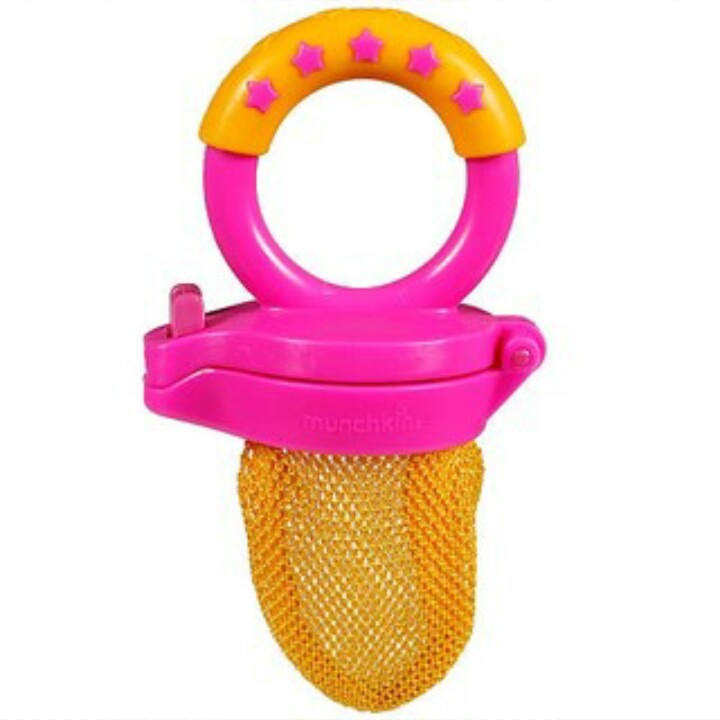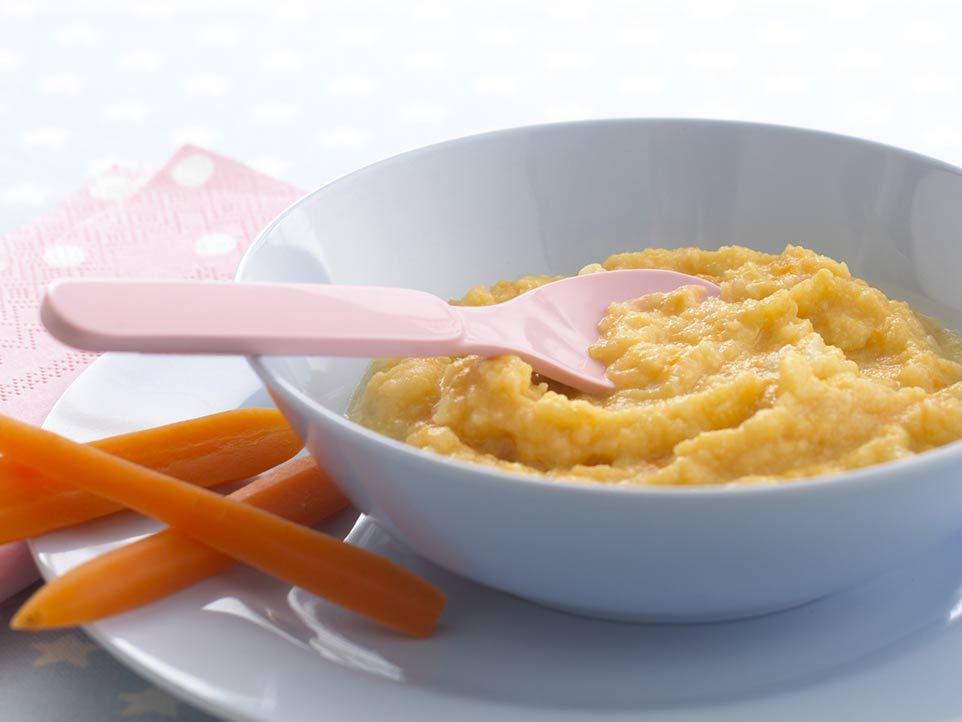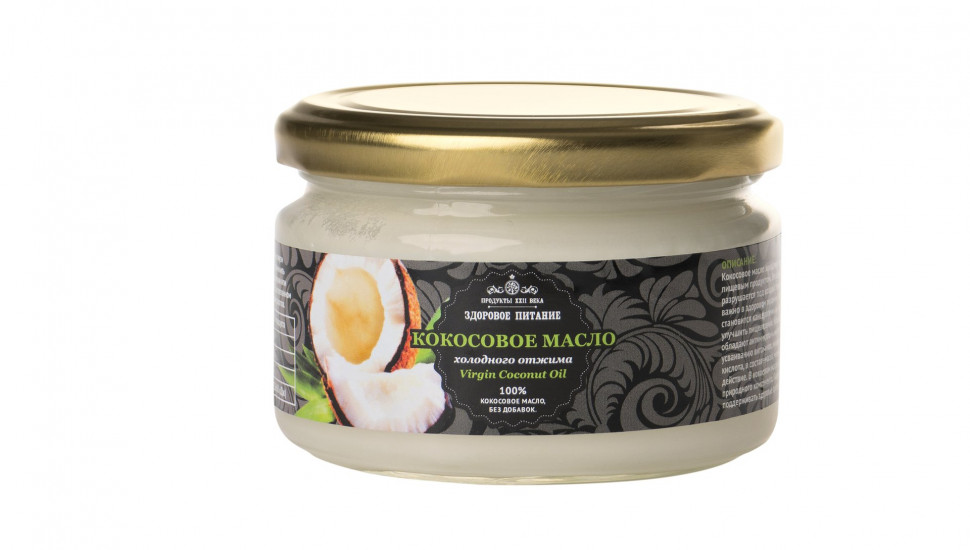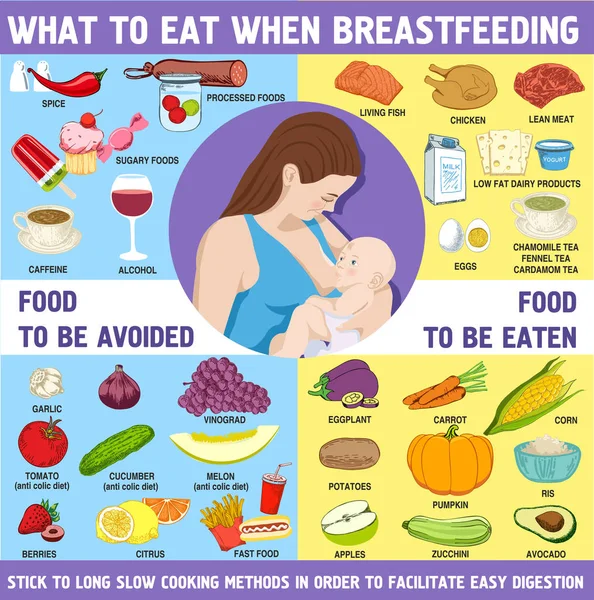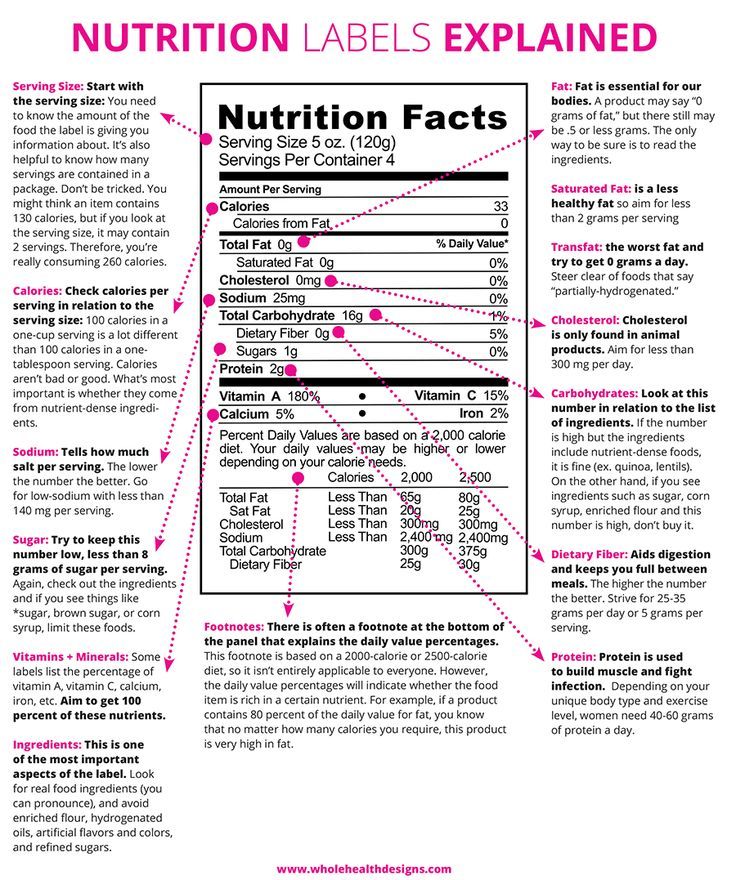Baby feeding mesh feeder
Ultimate Guide to Baby Feeders: Mesh and Silicone
You may have seen baby feeders, whether mesh or silicone, and wondered what they are for. They are a great tool for feeding babies and toddlers—and are especially awesome for teething relief. There are many on the market though, so today I’m sharing the best of the best.
Baby Feeder
A baby feeder is made up of an easy-hold handle and a little pouch with lots of holes. The idea is that the holes allow some of the flavor and texture of the food to come out, without the concerns that may come with larger pieces of food.
This means you can worry less when it comes to choking risks.
One thing to keep in mind: They don’t allow babies to have the full texture experience of the food—since the texture is mostly the mesh of the feeder. That means you don’t want to use one of these for every meal (or even most meals).
Lots of exposures to lots of textures helps babies and toddlers gain confidence in handling all sorts of foods, which can make feeding kids a lot easier over the long run.
But an infant feeder can be a handy tool to have in the mix, especially if on the go, starting to transition to baby food, or trying out a new food that has you a little nervous.
And they are a great way to offer cold teething relief to soothe baby’s gums.
Baby Fruit Feeder
Many people like to use baby feeders to offer fruit, either fresh or frozen, since the product is a safe way for baby to suck on and explore the flavor of a wide range of fruit.
TIP: Another name for this is Baby Fruit Pacifier.
Best Baby Food Feeders
Below are my top picks for infant feeders chosen for ease of use, durability, and ease of care (as in washing!). There are different materials listed, as well as specific information on each product.
Best Mesh Feeder
Munchkin Baby Feeder, sold in a set of two. (Or choose the ones that come with travel caps.)
This baby feeder has a streamlined, simple design of a mesh bag for the food and a ring for baby to hold onto. Small, digestible pieces of food come through so baby is getting some nourishment (and comfort if using for teething) without the risk of choking. It’s about $7 for two of them.
Small, digestible pieces of food come through so baby is getting some nourishment (and comfort if using for teething) without the risk of choking. It’s about $7 for two of them.
Best Silicone Feeder
Boon Silicone Feeder
This baby feeder, which is priced at under $6, is made from durable silicone and can be used with fresh or frozen foods. The interior stem forces food toward the tiny holes in the feeder and the small handle is sized just right for baby’s little hands.
Kidsme Baby FeederBaby Feeder Pacifier Combo
Kidsme Food Feeder
This popular Kidsme feeder has a replaceable silicone pouch that comes in two sizes, so you can adjust and replace as your child grows. It has a unique handle style that some babies may prefer and can be used as a pacifier too. It’s usually priced around $15 and is recommended for ages 4-24 months.
What baby foods should I put into a baby feeder?
Here are some fruits that are good to serve in a baby feeder:
- Raspberries, fresh or frozen
- Strawberries, fresh or frozen
- Blackberries, fresh or frozen
- Cantaloupe
- Honeydew
- Banana
- Mango, fresh or frozen
- Roasted sweet potato
- Roasted butternut squash
- Ripe fresh pear
- Fresh cucumber, skin removed
- Watermelon
- Cooked red meat such as steak
- Frozen grapes (These are NOT safe served to a child this age in any other way as they are a choking risk.
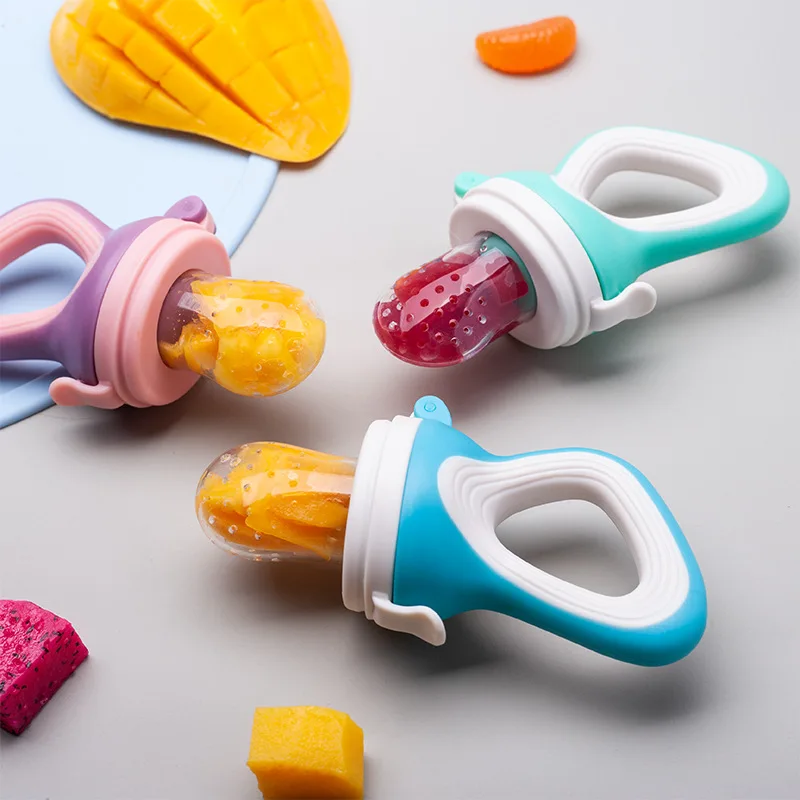 They are fine served inside the feeder, though.)
They are fine served inside the feeder, though.)
TIP: You can use frozen fruit or ripe fresh fruit that’s soft and easy to gum. Avoid any fruits or veggies that are very hard as baby may be frustrated by that texture.
Frequently Asked Questions
What age can baby use a mesh feeder?
Babies can use an infant feeder soon after starting solids around 6 months, or when they can easily hold it and bring it to their mouth.
How do I use a baby feeder to help with teething?
If you fill the feeder, whether mesh or silicone, with frozen fruit, you can soothe teething in infants who are eating solids or in toddlers. It’s cold and yummy, yet requires no real work for the child to suck on, so it’s comforting.
Are all of these baby feeders BPA-free?
Yes, if you choose a mesh baby feeder or one made from silicone, they are BPA-free.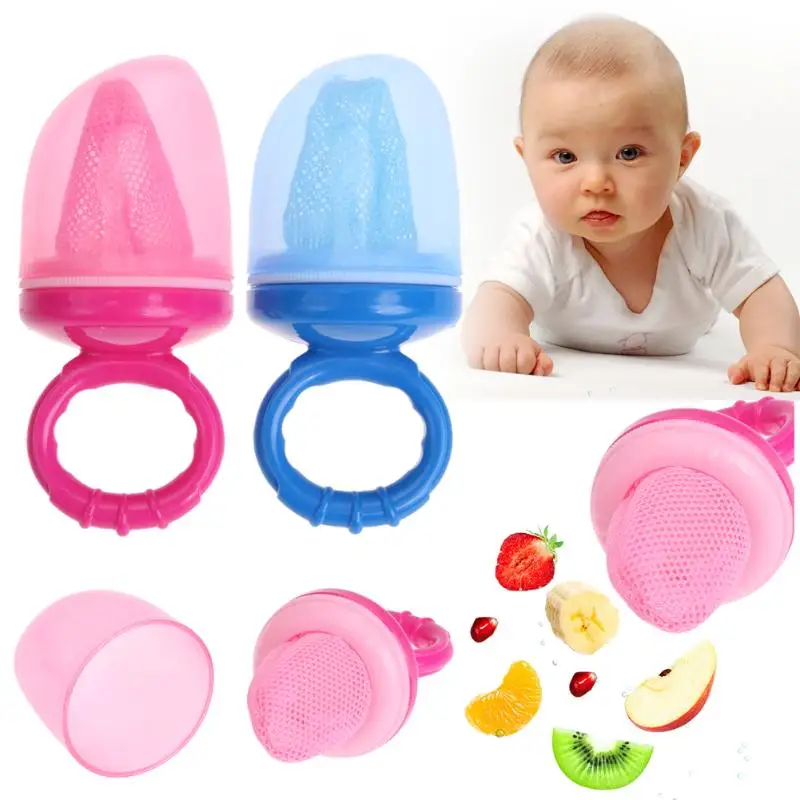
What’s the best way to clean a baby feeder?
Try using a bottle brush or just running water to clean out the mesh. It should be fairly easy to clean if you avoid letting it sit too long with food in it!
Are baby feeders good for babies?
The one downside could be that if you rely on them too much, the child learns the texture of the feeder, rather than of the food. This can make it harder for a child to learn to move actual food around in their mouths and harder for them to accept a range of textures in the future when you don’t want to be using the mesh feeder as much.
Because of that, I recommend using this product at limited times such as when on the go at a restaurant or to help sooth a teething infant, baby, or toddler.
This is not recommended as a way to feed your child at every meal.
If you are worried about choking, review this information on toddler choking and trust that if you serve foods that are easy to squish between your fingers, baby is sitting down at meals, and you are with them, they will learn to eat like so many other kids who have gone before them!
You May Also Like
- Best Baby Puffs
- Favorite Sippy Cups
- Best Snack Containers
- Best Lunch Boxes
- Favorite Suction Bowls
- Top High Chairs
I’d love to hear your thoughts on baby feeders in general or on these specific products, so please comment below to share!
This post was first published May 2019.
5 Popular Baby Food Feeder Options to Keep Baby Safe and Less Messy
Looking for a baby food feeder? Read on to discover the advantages of a baby food bottle feeder, mesh baby food feeder, silicone baby food feeder, reusable squeeze pouch baby food feeder, and a baby spoon feeder. These can help your child learn how to start to transition from baby feeders to more soft foods and someday solid foods as they get older.
I love my kids when are babies, but I don’t always love taking the time to sit there and feed them baby food from a jar (and I certainly don’t love taking the time to make my own baby food purees). I’m all about that baby-led weaning and finger foods! I am a busy mom with other kids and work and school so easy is my approach to introducing baby foods.
I wait until at least 6 months before introducing any type of baby food. I usually buy some rice cereal and mix it with a little formula or pumped breastmilk (if I have any pumped) and give it a go. I may then try spoon-feeding some simple, single-flavor jarred baby food to my infant.
I usually buy some rice cereal and mix it with a little formula or pumped breastmilk (if I have any pumped) and give it a go. I may then try spoon-feeding some simple, single-flavor jarred baby food to my infant.
Once they get more a hang of the idea of food, and can move food around in their mouth and swallow better, I start giving the baby small, soft bits of whatever we are eating at the table, along with baby-friendly puffed cereals, freeze-dried yogurt bites, and more pureed baby foods perhaps from a baby food feeding pouch.
The biggest fear I have every time I start feeding babies is the fear of them choking.
This is one of my greatest fears, not just at the dinner table, but as they crawl around and find all the tiniest bits of whatever all over the floor and stick it in their mouths! I have pulled so many pieces of paper, leaves, grass, and toys out of my fifth baby’s mouth. It’s nerve-wracking!
It’s nerve-wracking!
And that’s why I love the idea of a safe baby food feeder.
Why it works for easy feeding
Using useful tools like a mesh baby feeder is perfect for helping your child transition to soft foods and solid foods. It’s also an easy way to help your baby’s gums transition to eating a small size of food as well. Baby fruit feeders are great because they are made of safe materials with tiny holes that allow your child to hold onto the food-grade silicone handle and start to figure out the best way to eat.
This is a great way to introduce small amounts of food to a teething baby or to introduce them to new flavors of food in a fun way.
Keep in mind that a baby’s age and the baby’s diet needs to be kept in mind. Young babies shouldn’t be eating the same thing as an older baby so you still have to be very careful as well.
Use these for little hands. They also work great to work on hand-eye coordination as they’re putting them up to their mouths. I also love that they’re made for easy cleaning, too!
They also work great to work on hand-eye coordination as they’re putting them up to their mouths. I also love that they’re made for easy cleaning, too!
Baby Food Feeder
Using a baby food feeder is a new thing for me to try with my fifth baby, but I like it so much!
Not only does it make feeding babies safer but makes mealtime less messy! (See my post on limiting messy eating toddlers for tips for the slightly older crowd!)
I discovered that there are several very popular baby food feeder options out there today, so I wanted to discuss the various options and what makes them each great or not so great and where you can pick them up.
Munchkin Baby Food Feeder
To help facilitate this discussion, Munchkin sent me a few baby food feeders and a cool sippy cup cleaning brush set to review.
#1 Baby Spoon Feeder
This type of baby food feeder is where you dispense baby food through a baby food dispensing spoon.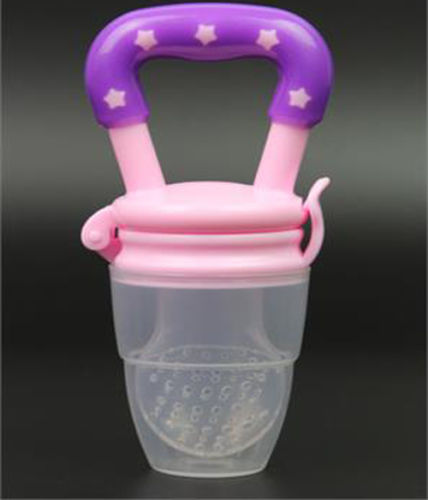 You simply fill up the soft silicone end with soft pureed foods or things like yogurt and then you squirt baby food out from the silicone part out onto the spoon!
You simply fill up the soft silicone end with soft pureed foods or things like yogurt and then you squirt baby food out from the silicone part out onto the spoon!
I tried ours out with some Greek vanilla yogurt. While it still ending up being messy and it made all sorts of fun “farting” noises as I pushed out air along with the yogurt, which then kinda sprayed everywhere, it was pretty easy to use.
What I like about this versus a bowl or jar that you are spoon feeding your baby from, is there is less back and forth from the jar or bowl to the baby’s mouth. When babies are at the “swat at everything” stage, it means less chance of baby food ending up on the floor, or my lap.
So, still kinda messy but better!
It’s pretty easy to clean out, and you can take the squeeze feeding spoon on the go as it comes with a hard plastic cover you just snap on to the end of the spoon.
They come in colors blue, green, and pink and are $7 each on Munchkin.com. You can also find them on Amazon (though for more).
Munchkin Baby Mesh Feeder
I have seen many friends over the years who use and love these mesh baby food feeders (and even pediatric occupational therapists highly recommend mesh feeders)! They are especially handy as a baby teething feeder! You can put some frozen raspberries or other frozen fruit or even an ice cube in it and let your baby safely gnaw and gum it, cooling their poor aching teething gums!
The Munchkin fresh food feeder is perfect in that you can give your baby chopped up pieces of fresh fruits and vegetables without having to puree them to a pulp! The mesh prevents large pieces from coming through so they won’t chock on the fresh food! Yeah!
I put some cut grapes, pieces of chicken, and more in mine when I tested it out to give to my 8-month old baby. She loved gnawing on it!
She loved gnawing on it!
Some of the best foods for a mesh feeder include:
- raw apples
- chunks of melons
- frozen blueberries
- pears
- peaches
- raw carrots
- nectarines
- chunks of meat
It is recommended to empty and wash out your mesh feeders shortly after use to make it easier to clean out and prevent any food going bad in there! I found it super easy to rinse out with a little dish soap at my sink. But some foods like bananas can be more difficult to clean out of it.
The Munchkin Fresh Food Feeder comes in pink/purple, green/blue, and yellow/green colors for $3 each on Munchkin.com. You can also opt for one of their Munchkin Deluxe Fresh Food Feeders that come with a convenient on-the-go cap with snap-tight closure for $4 each on Munchkin.com. Amazon has the 2-pack fresh food feeders that I received for $5.99.
Munchkin Silicone Baby Food Feeder
Similar to the above fresh baby food feeder, there is also a Munchkin silicone baby feeder too (but I didn’t receive this product to try out).
The silicone baby feeder is actually designed for babies ages 4+ months whereas the other ones are designed for babies 6+ months old.
The silicone baby food feeders are easier to clean, but smaller and actually designed for baby food purees rather than large fresh food, though some people still put large pieces of food in them (but it’s harder to fit them in these).
Munchkin silicone baby food feeders come in pink, green, and blue and includes an on-the-go cap for $4.50 on Munchkin.com.
Baby Food Bottle Feeder
I don’t use baby bottles hardly at all, so maybe that is why I had never heard of a baby food bottle feeder before!
There are some bottle manufacturers that offer alternative bottle tips that allow you to squeeze out baby food from inside the bottle to the base of a replacement bottle head – a food dispensing spoon!
With our baby twins we had used baby bottles that could swap out tips for sippy cup tips, and we used those silicone sippy cup nipples with moderate success (until they got teeth and stuck utensils, pencils, and other objects into the opening making anything but spill-proof).![]() The baby food feeder bottle nipples also make sense!
The baby food feeder bottle nipples also make sense!
It doesn’t appear like there are many bottle companies that actually make these anymore. Nuby used to make one called the Nuby Infa Infant Feeder and the Nurtur Care Infa Feeder but they are no longer available for purchase. I did find that Sassy offers a baby food nurser bottle (on BuyBuyBaby and Amazon).
The cool thing about this product is that it has a vacuum disc that keeps air out and moves cereal or baby food without clogging. Plus there is a handy travel cover so you can take baby food on the go much easier. The spoon is also like a soft nipple which is easier on those little mouths than a regular spoon.
Reusable Squeeze Pouch Baby Food Feeder
I recently got a reusable squeeze pouch baby food feeder from Noobie Box‘s Noobie Eat Box. I have always wanted one of these because I hate how wasteful and expensive all these baby food pouches out there! You can easily fill one of these up with apple sauce, your own fruit purees, or yogurt and save yourself a ton of money, time, and trash!
Squeeze pouches are super handy for feeding soft pureed foods to babies (and older kids too – let’s be honest!), especially on the go! No utensils required and when they get older can safely suck them down themselves without making any messes.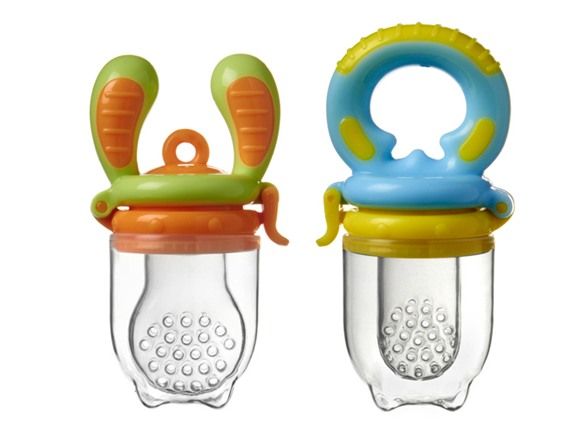
My baby at 8-months old cannot manage one of these on her own (she loves to squeeze them) but uses baby food squeeze pouches has helped her develop some sucking skills, skills that will come in handy when introducing sippy cups with straws.
If you are interested in picking up reusable squeeze pouches, there are many options on Amazon from brands like Squooshi, WeeSprout, Baby Brezza, Kiddzo, and others costing about $9.99-$19.99 for multiple reusable pouches.
Munchkin does not carry any baby food pouches, but they do have Click Lock Food Pouch Spoons! They work with most leading pouch brands. The spoons are twisted onto the ends of the pouches, allowing you to squeeze baby food from pouches onto a baby-friendly spoon. They’re designed for kids ages 4+ months. It’s pouch feeding without the mess (hopefully).
You can get a 2-pack of the Munchkin Click Lock Food Pouch Spoons for $4 on Munchkin.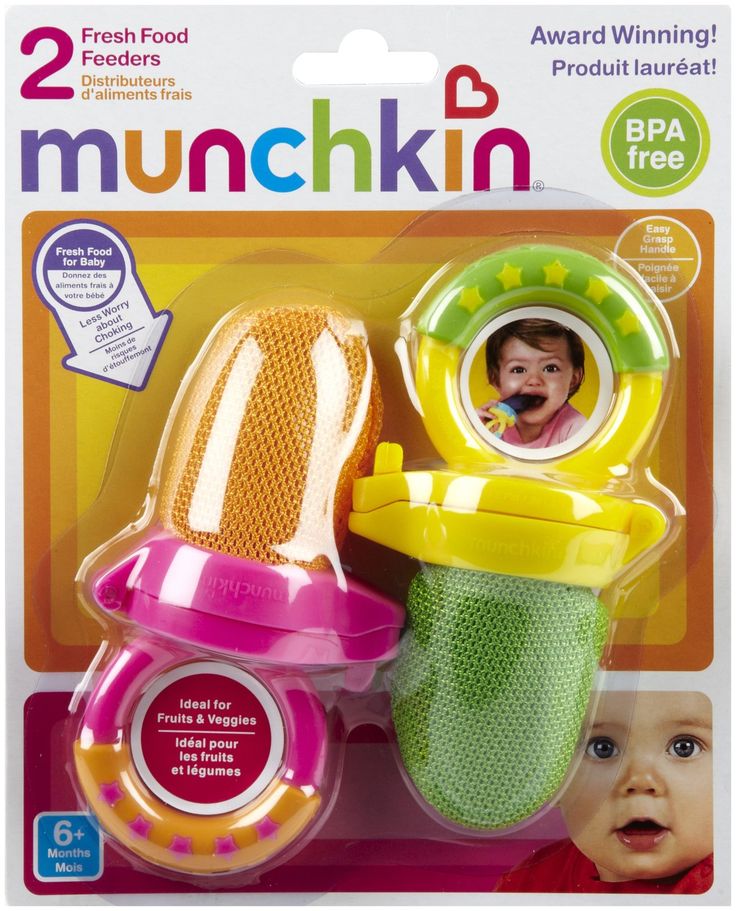 com.
com.
If you want to pick up several of these great Munchkin baby food feeders, remember that you get FREE Shipping on Munchkin.com Orders Over $25 + FREE Returns! Plus, you can also Sign up to receive an additional 10% OFF!
I’m so glad there are so many great and innovative baby brands making products to help me feed my baby safer and cleaner!
I’d love to know what you’ve thought about various baby food feeders you’ve used over the years, sharing your own reviews of which one(s) is your favorite.
Be sure to check out these other great posts:
- Thrifty Mom’s Guide to Essential Baby Feeding Supplies
- 15 Must-Have Baby Items
- How to Take Care of a Baby’s First Teeth
- How to Transition Baby from Bottle to Sippy Cup
- What Happens When You Grow Up to Be a Picky Eater Adult
which one to choose, what can be put inside, from what month and how to use it correctly, rating of the best silicone nibblers and nibblers with mesh made the first primitive nibblers.
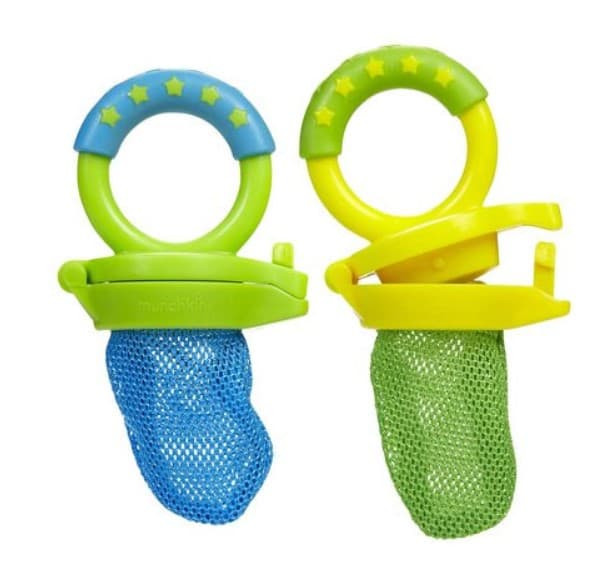
Because, firstly, breastfeeding all the time is not always convenient, and secondly, sooner or later the child must be accustomed to regular food - and this must be done safely so that the baby does not choke and choke.
Therefore, women took a thin cloth, ideally gauze, wrapped pieces of food in a flap: bacon, bread, fruits, and gave their child to chew.
The baby is full and busy, plus - his delicate gastrointestinal tract gets used to food other than breast milk or formula.
What is a baby nibbler
This is a special device for introducing complementary foods, usually looks like a large pacifier.
- A modern nibbler consists of a special handle, a fabric or silicone mesh, a plastic ring for fixing it and a protective cap for storage, says pediatrician, pediatric gastroenterologist, nutritionist Alena Chubarova . - Fabric or silicone - the choice largely depends on your preferences. A mesh (nylon) nibbler is usually larger and can hold larger pieces, while a silicone nibbler is somewhat easier to clean.
From what month you can use the nibbler
Many parents are ready to buy everything that is sold in children's stores even before the birth of the baby. But a nibbler for a newborn is a completely unnecessary thing. You can use it for its intended purpose much later.
- Nibbler can be used no earlier than the age when it is already possible to introduce complementary foods, i.e. not earlier than 16-17 weeks of life, says Alena Chubarova.
However, some parents give silicone nibblers to the child before, but without food inside - as a toy or teether. However, this is not entirely rational: the baby can quickly gnaw through silicone (especially if the first teeth come out early) and for such purposes it is better to buy a special teether.
Which nibbler for children to choose
So, what kind of nibblers are:
- silicone,
- fabric, with a "mesh".
There is no fundamental difference between them, you can buy something that seems more convenient to you. Other selection criteria are more important. When buying a nibbler, you should pay attention to the shape and size of the handle, the quality of the product, the shape of the “nipple” itself. Sometimes it happens that due to the strange shape, part of the food in the nibbler remains unchewed, and some models are inconvenient to care for. These are all things to consider too, so it's helpful to read reviews from other parents before buying a nibbler for kids.
Other selection criteria are more important. When buying a nibbler, you should pay attention to the shape and size of the handle, the quality of the product, the shape of the “nipple” itself. Sometimes it happens that due to the strange shape, part of the food in the nibbler remains unchewed, and some models are inconvenient to care for. These are all things to consider too, so it's helpful to read reviews from other parents before buying a nibbler for kids.
Silicone
Photo: yandex.market.ruLooks like a large nipple container with small holes. Such nibblers wash well, many models can be scalded with boiling water, boiled, washed in a dishwasher and prepared in an electric sterilizer. However, for example, it will be problematic to chew a hard apple through such a nibbler, since silicone as a material is quite dense.
With mesh
Photo: yandex.market.ru In this case, instead of a pseudo-dummy, a nylon mesh is used, this option is just as close as possible to the self-made prototype of a nibbler.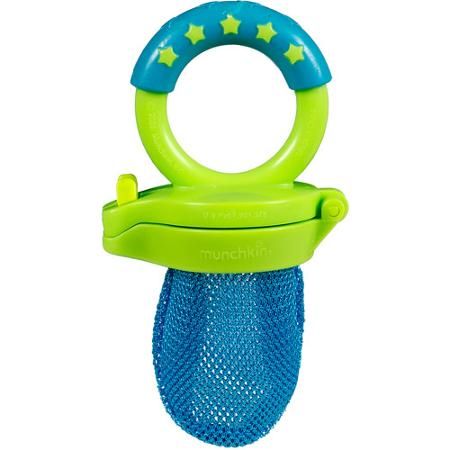 Such a device is not very convenient to maintain, because the mesh is cleaned worse than silicone, manufacturers do not recommend boiling it, and mesh bags will have to be changed more often.
Such a device is not very convenient to maintain, because the mesh is cleaned worse than silicone, manufacturers do not recommend boiling it, and mesh bags will have to be changed more often.
But in such nibblers, due to the low density of the material, almost all products can be used, with the exception of liquid ones.
Rating of the top 5 best nibblers for children
On sale you can find both silicone models and nibblers with nylon mesh. In fact, they are all similar, differing mainly in size, shape, design and price. When choosing a nibbler, the first two criteria are especially important: it depends on whether it will be convenient for the baby to chew food and how easy the nibbler will be to care for.
1. BRADEX - Bunny
BRADEX - Bunny. Photo: yandex.market.ru Nibbler with a soft silicone "nipple" will help to introduce porridge, any fruits and vegetables into the baby's diet. Judging by customer reviews, a child can even cope with a piece of an apple, thanks to this device, since there are many holes on the “nipple” and they are large enough for fragments of not very soft food to seep through them.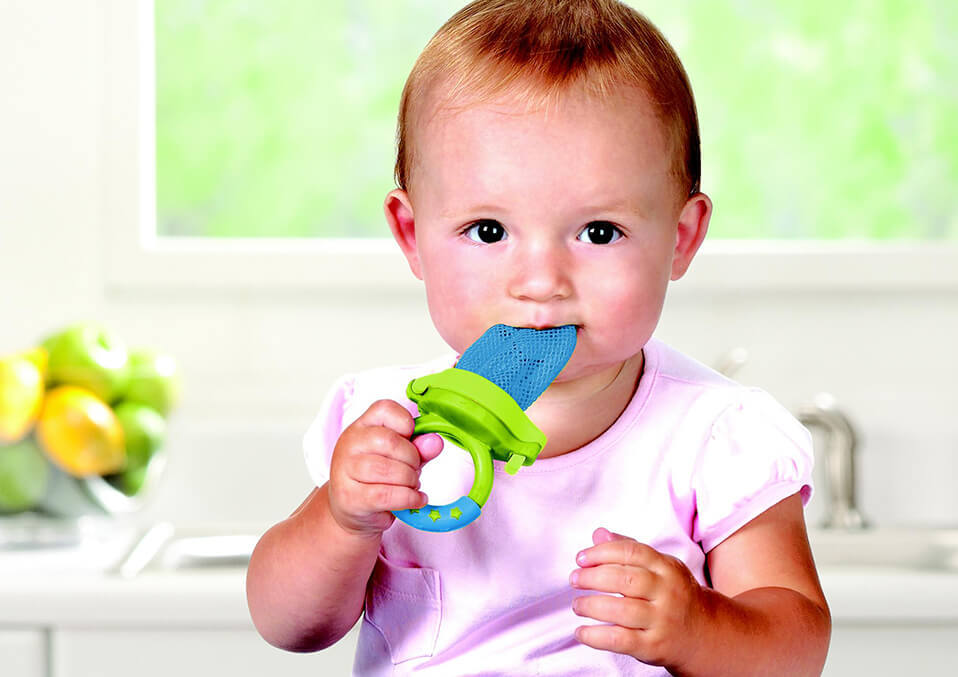 In this case, the risk of choking is excluded.
In this case, the risk of choking is excluded.
Inside there is a special piston that pushes the food to the holes. Therefore, the baby will be able to eat almost everything that adults put in the nibbler. And after that, little will remain in the “nipple”.
The handle is made in the form of bunny ears: the child will be comfortable to hold the nibbler, regardless of the size of the hand. Between the ears there is a ring, where, theoretically, you can attach a chain so that the nibbler does not fall in the process. But the diameter is small, so it may not be convenient for everyone to use it. A protective cap is provided for storage.
Key features
| Material | Silicone |
| Age | From 6 months |
| Features | Has a special piston that pushes food to the tip of the structure |
Pros and cons
Ease of use; a piston is provided that helps the child finish eating everything; interesting design.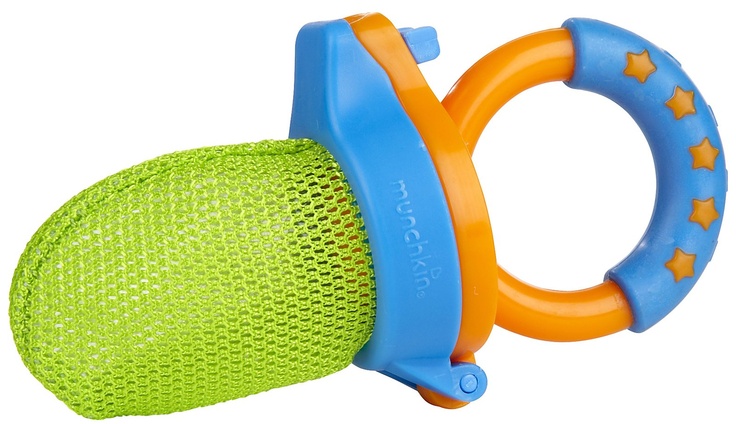
Banal choice of colors: only pink and blue.
2. Mepsi
Mepsi. Photo: yandex.market.ruSimple and easy to use nibbler. The product consists of a base with a handle, two interchangeable soft silicone meshes and a cap, which is necessary to keep the nibbler clean. By the way, silicone nets of different shapes - you can choose the one that is convenient for your baby, and the manufacturer notes that they are simply designed for different types of food.
Fruits, berries, vegetables and even meat can be placed in the nipple. There is no special piston that helps push food. But some parents in the reviews note this as a plus - there are no extra parts, it's easier to use the product and take care of it.
The handle is closed, in the form of a "heart", designed so that it is convenient for the baby to hold the nibbler in his hand. But if the palm is large, it may not be so easy for the child to cope with the device.
Key features
| Material | Silicon |
| Age | From 4 months |
| included a shift net |
Plus and Classes two formed sets; easy-to-care product; rich selection of colors.
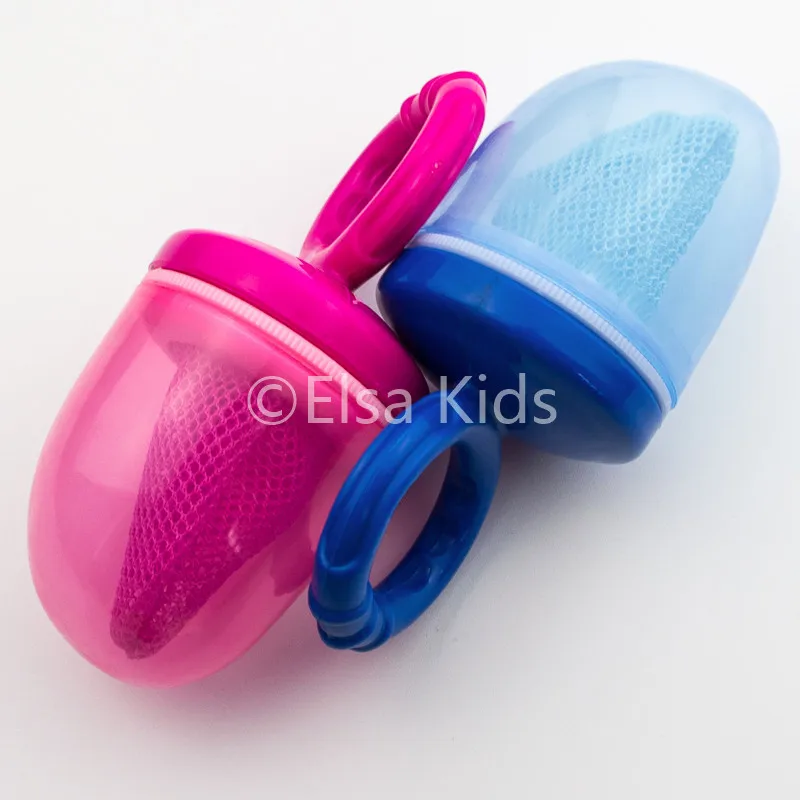
The handle may be uncomfortable for a large child.
3. Canpol babies
Canpol babies. Photo: yandex.market.ruAn unconventional nibbler: instead of a handle, it has a small oblong container, so outwardly it looks more like a feeding bottle than a pacifier. Thanks to this, you can put not only fruits, berries or soaked cookies into the nibbler, but also, for example, soup or mashed potatoes - and not be afraid that the child will choke. And the volume is larger than that of a number of analogues. However, it is possible that some food may remain inside the nibbler given its elongated shape. Especially if it's not liquid food.
The device itself is ergonomically shaped, the nibbler will be comfortable for the baby to hold in his hand, and storage is not required.
Main characteristics
| Material | Silicon |
| Age | from 6 months |
| Features |
pluses and half a minute also suitable for introducing soups and purees into complementary foods; ergonomic shape.
Some food may remain inside the nibbler; no color options.
4. "Roma + Mashka"
"Roma + Mashka". Photo: yandex.market.ruAnother silicone nibbler in our rating is designed for babies from 4 months. Inside the grid you can put fruits, vegetables, cookies or a piece of bread. In this model, the handle is also a press that helps to push food out through small holes in the “nipple”.
The handle itself, by the way, has an unusual shape - two rings, like scissors. This may not be very convenient for some children.
Wash the nibbler in warm water using a suitable product, and sterilize in any convenient way, including electrical appliances. There is a protective cap for storing the nibbler.
Main characteristics
| Material | Silicon |
| Age | from 4 months |
| Features | PERSON |
| Material | Nylon |
| Age | From 6 months |
| Features | Wide ring handle |
Pros and cons
Comfortable ring-shaped handle; mesh cleans well.
Hard to find commercially; a modest selection of colors.
How to use the baby nibbler
As we have already said, this simple device helps to introduce new foods into the baby's diet. However, do not rush to immediately run to the store or pharmacy: think about whether you really need a nibbler.
— The Nibbler is not an essential item that must be purchased. We can easily introduce all complementary foods without it, - emphasizes Alena Chubarova. - Nibbler can be used as an intermediate step for children who are resistant to the introduction of complementary foods. That is, in order to at least in this way introduce the child to new tastes and sensations.
How else can you use a nibbler for children at home?
- The Nibbler can help your baby eat slippery foods that are hard to hold, such as peaches or avocados.
- Suitable for reducing teething discomfort as chilled product can be put into it.
- Can be great to keep the baby busy for a while to relieve the parents a little.
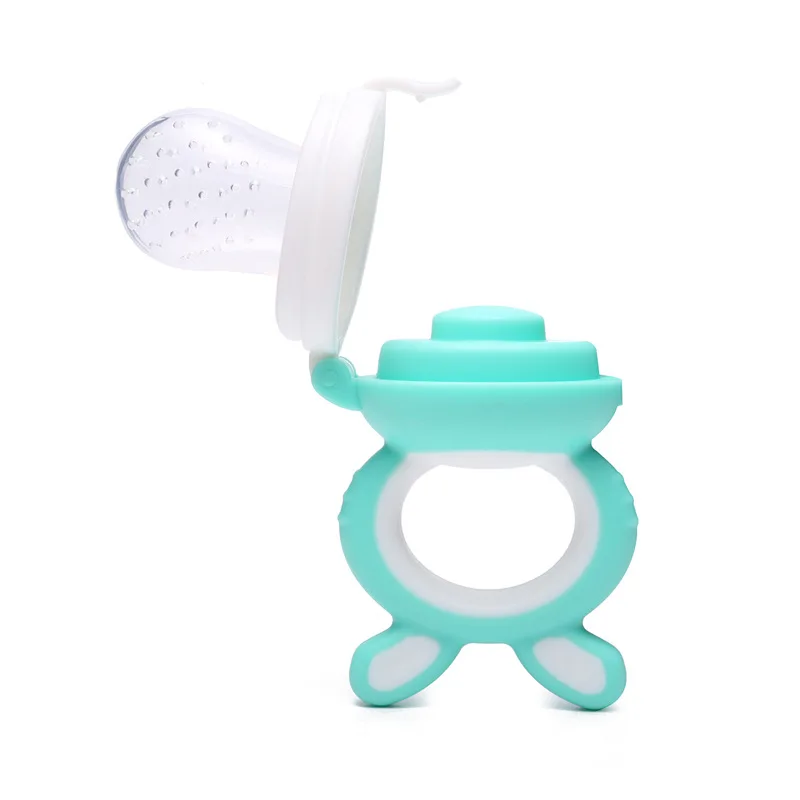
How to use the nibbler correctly? Everything is as simple as possible and nothing new has been invented since the prototype of this device was used by our mothers and grandmothers.
The product you want to give to the child is placed in the net, then the net is fixed. You need to give the nibbler to the baby and, perhaps, to begin with, help him by slightly pressing on the “nipple” (if you have a silicone model): to show that there is a “yummy” inside.
— The nibbler has an easy-to-grip handle and requires less coordination than eating with a spoon or fingers, says Alena Chubarova. - However, at the same time, the baby does not learn to take food with his hands, and this is important for the development of fine motor skills. In addition, parents should understand that a nibbler does not teach a child safe chewing lessons. When children take a bite of a piece of food and move it around in their mouth, they learn to chew. For a baby, this is a huge yet unknown job, which requires significant coordination, strength and endurance of the muscles of the jaws, cheeks and tongue. This is not an innate skill and a child can only develop it through practice. Nibbler teaches the child only to clench and unclench the jaws, but does not help to understand the process of chewing. So even if you use a nibbler, don't do it all the time. And remember that there is no urgent need for it: you can simply give products that match the age of the child in terms of consistency and texture.
This is not an innate skill and a child can only develop it through practice. Nibbler teaches the child only to clench and unclench the jaws, but does not help to understand the process of chewing. So even if you use a nibbler, don't do it all the time. And remember that there is no urgent need for it: you can simply give products that match the age of the child in terms of consistency and texture.
What can be put in a nibbler
Today there are many variations on the market that allow you to introduce almost any food into your baby's diet. The main thing to remember here is that complementary foods should be appropriate for the age of the baby. Of course, you can put mango or pineapple in a nibbler, but not at 4 months - at this age, the child's gastrointestinal tract is not yet ready to get acquainted with the exotic.
In addition, it is important to take into account the individual tolerance and consistency of the products themselves. For example, putting raw carrots in a silicone nibbler is pointless, as well as liquid puree in a nibbler with a fabric mesh.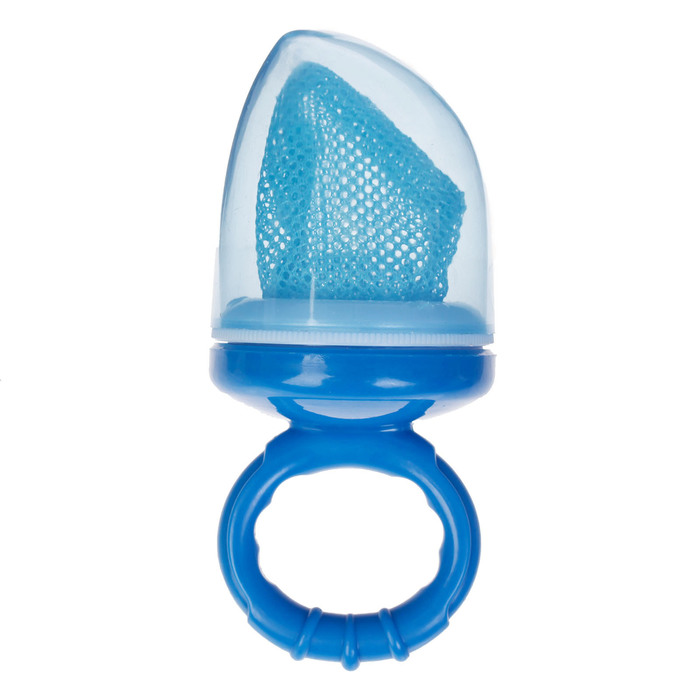 In the first case, the child will not be able to get to the vegetable and will remain “unsalted slurping”, and in the second, everything will flow out before the baby puts the nibbler in his mouth.
In the first case, the child will not be able to get to the vegetable and will remain “unsalted slurping”, and in the second, everything will flow out before the baby puts the nibbler in his mouth.
The following options are ideal for feeding with a nibbler: banana, pear, apples, peaches, cooked vegetables: zucchini, pumpkin, cauliflower, boiled meat. Some nibblers can be used for puree.
Apple and pear
Photo: pixabay.comThese are hypoallergenic fruits, which are included in babies' complementary foods earlier than others. For example, applesauce is usually allowed to be given to babies from 4-5 months.
It is important to choose the right products. Fruit should be ripe, but not too ripe, ideally grown in the region where you live. Apples are better to take green varieties. Before putting the pieces in the nibbler, you need to prepare the products: wash, peel, cut into medium-sized pieces. If you're just introducing fruits into your diet, it's best to lightly bake them first.
Apples
Pears
Zucchini
Photo: pixabay.comAs a rule, the very first vegetable introduced to children. This product is suitable for everyone, does not cause allergies and carries many useful substances. Of course, you can’t give it raw to children. But you should not cook either: it can lose many valuable substances and lose its shape. Optimal - steam the zucchini, cool, cut into small pieces and put in a nibbler.
Learn more
Peach
Photo: pixabay.comThe most important thing is to thoroughly wash the fruit and peel it from the "velvet" peel. A ripe peach is quite juicy, so the child can easily taste a new taste even through a dense silicone mesh.
Learn more
Potatoes
Photo: pixabay.com It would seem that such an elementary product, but it is not introduced into the baby's diet immediately - but closer to 7 months. All because of its starchy nature. Pre-peeled potatoes are best cut and kept in water so that excess starch is washed out.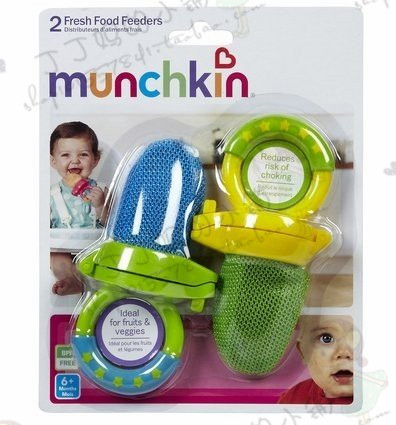 And then it can be baked or boiled and given to the baby in a nibbler (after cooling, of course).
And then it can be baked or boiled and given to the baby in a nibbler (after cooling, of course).
Learn more
Rabbit meat
Of the protein-rich foods, this dietary meat often appears first on the menu of a growing child. Choose a product from a trusted seller with a good reputation, wash thoroughly before cooking. It is desirable to cook without salt at all. Considering that meat is a fibrous product, get ready for the fact that most of it will remain inside the mesh. But the child will get acquainted with new sensations, prepare his body for such food and saturate it with useful nutrients.
Reviews of doctors about nibblers for children
“There are certain precautions,” says pediatrician Alena Chubarova. - When you give a nibbler to a child, there should always be an adult nearby. In the process, the child should sit in the same way as during normal feeding. You need to wash the nibbler after each use, and if you notice that it is damaged or has begun to wear out, immediately replace it with a new one or remove it if it is no longer necessary. If the child does not like the nibbler, do not insist - postpone it for a week or two.
If the child does not like the nibbler, do not insist - postpone it for a week or two.
- When choosing a nibbler, you need to pay attention to some characteristics:
- no foreign taste and smell of the product,
- strength and safety of materials (must meet quality standards),
- ease of use and maintenance.
It is better to choose models that are lighter in weight, and it is also important to pay attention to the clasp - it must be reliable and airtight, - says pediatrician Ekaterina Mikhaltsova .
Popular Questions and Answers
Our expert, pediatrician Ekaterina Mikhaltsova, answers readers' questions about the use of a nibbler for children.
What fruit can I put in the nibbler?
Any berries, fruits, but pitted. It can be bananas, kiwi, peaches, apples, pears, apricots. Citrus fruits can also be put in a nibbler if the child does not have an allergic reaction.
Until what age can a child be given a nibbler?
Approximately up to 7-8 months, then there is no reason to use it.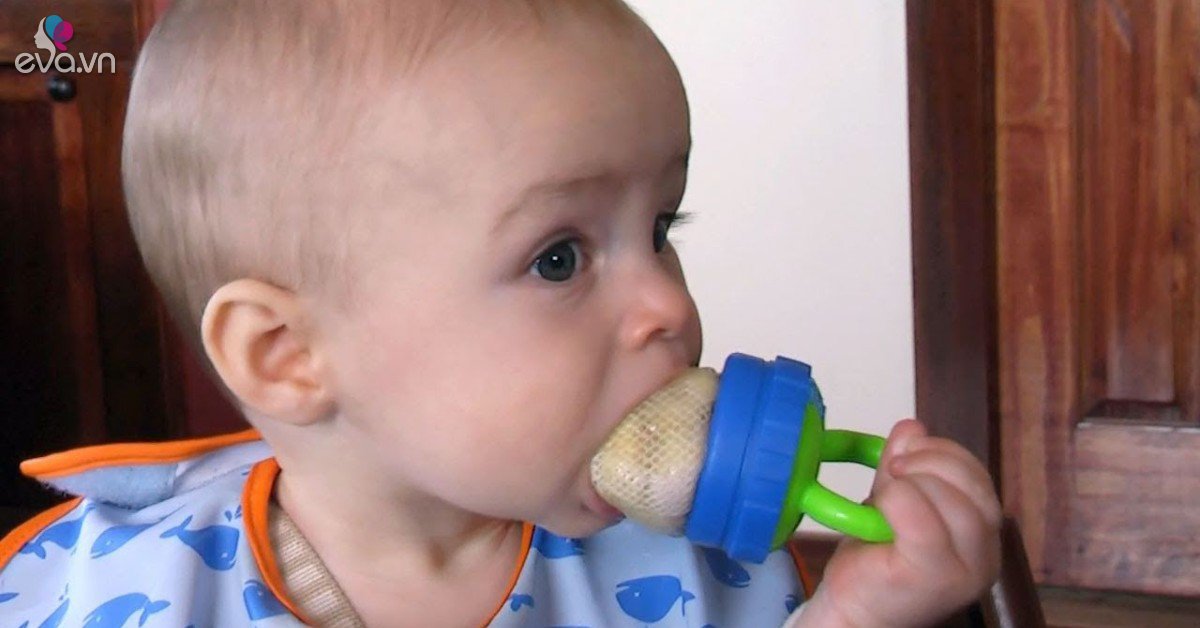 The fact is that the nibbler does not teach the baby to chew and bite. In general, many parents can refuse this newfangled device, provided that the baby does not resist the introduction of complementary foods, and he has a good food interest.
The fact is that the nibbler does not teach the baby to chew and bite. In general, many parents can refuse this newfangled device, provided that the baby does not resist the introduction of complementary foods, and he has a good food interest.
Can you make your own nibbler?
Making a homemade nibbler is very easy. Many different options can be found today on the Internet.
Is the nibbler safe for a child?
Nibbler is completely safe when used correctly. The main condition: give it to a child only under the supervision of an adult.
What is a nibbler for feeding: how to choose a nibbler (photo)
The first months of a baby's life have passed and it's time to introduce him to solid food. Yes, and how you want to pamper him with new delicacies - fresh fruits and vegetables. If the baby has already tasted plant foods in the form of all kinds of purees, and you want to treat him, for example, with a fresh apple or carrot, then the nibbler will become an indispensable and safe assistant in this matter.
Contents of the article
- 1 Nibbler: what is it, what is it for and how to choose the right nibbler
- 2 What can you put in a nibbler
- 3 How to use a nibbler
- 4 At what age can you give your baby a nibbler Rules 5
- safety when using a nibbler
- 6 Is it worth accustoming a child to a pacifier
Nibbler: what is it, what is it for and how to choose a suitable nibbler
A baby, without the risk of choking and swallowing a piece of unground food, chews a mesh filled with it of a special invention - a nibbler . Simply put, this is a special mesh for safe chewing, where the product is placed. Using this device helps to teach the baby to chew. It is sometimes called a fruittaker. It is more correct to call the device feeder. The name comes from the English feeder (feeder, feeder, breadwinner). Initially, feeders were sold in Russia under the Nibbler brand of the Nuby company. So the name "nibbler" appeared.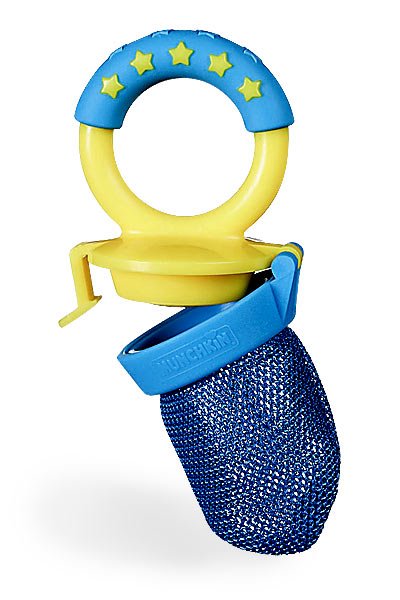
The device helps the child learn a new form of food and allows the mother to find time for other activities or leisure. After all, a daughter or son will be happy to chew a net with a treat, and at this time, mom will have time to cook dinner or enjoy the silence.
Attention: never leave a child with a nibbler unattended.
There are two types of nibblers available in children's shops:
- Nibbler with mesh made of special fabric
- Nibbler with silicone mesh
Both types are available in different colors with ring or wand handle. Which one to choose, each mother decides for herself.
Fabric mesh feeder looks like this:
Nibbler consists of a replaceable mesh, fixing ring, ergonomic handle. In some devices, there is an internal lid or a water container built into the handle, which, when cooled, allows you to keep the product fresh longer. The cap-cap is put on the grid itself and tightly adjoins the handle.
Replacement mesh can be used up to 3 months. After it is recommended to replace it. Replacement nets for nibbler are sold separately or in a set of several pieces. They are white and colored, universal or for a particular brand of nibbler. Mesh parts are made of durable and safe materials, do not contain harmful substances. Replaceable mesh is securely attached to the plastic handle. Pieces of food will not pass through the holes in the grid.
Silicone mesh feeder looks like this:
Silicone feeder (nibbler)It is also made from environmentally friendly materials. This mesh is easy to clean. It is necessary to replace the mesh if it is damaged or purchase a new nibbler. When the first teeth appear, a child chewing with zeal can gnaw through the silicone part.
Many moms find the silicone nibbler more practical and comfortable.
What can be put in a nibbler
At a time when our grandmothers were still young mothers, children put some bread in a piece of gauze, wrapped it up and gave it to chew.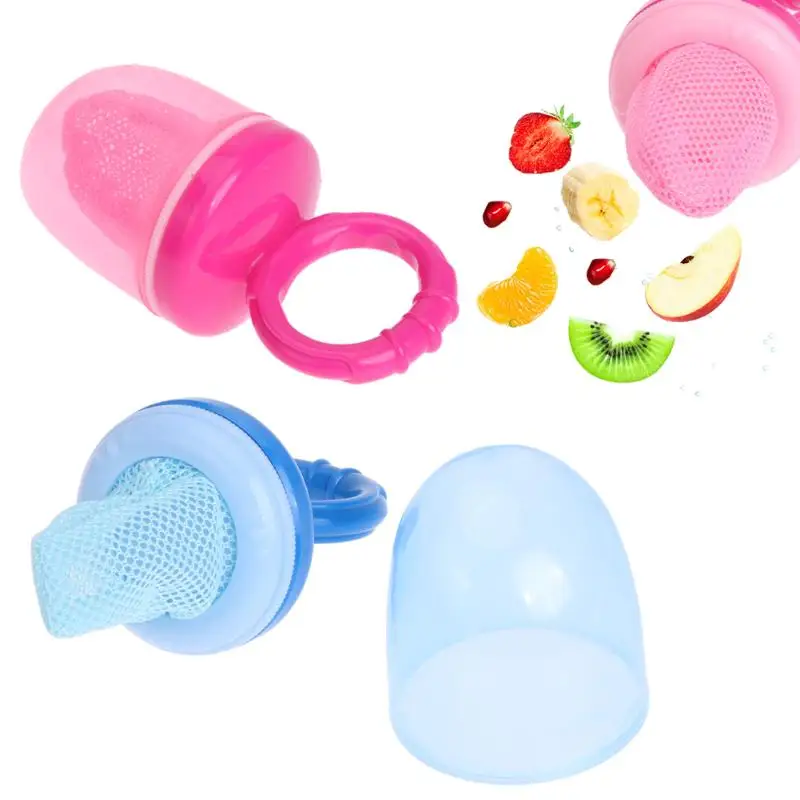 It was the first kind of mesh for chewing. With the help of a modern nibbler, the baby can enjoy many products:
It was the first kind of mesh for chewing. With the help of a modern nibbler, the baby can enjoy many products:
- Fruit: apple, banana, pear, avocado
- Berries
- Fresh or cooked vegetables: carrots, cucumbers, courgettes, etc.
- A piece of boiled meat
- Drying or bread
Attention: put in the nibbler products suitable for the age of the baby.
How to use the nibbler
Before giving it to your baby, follow a few simple steps:
- After separating the nibbler into parts, wash with hot water and soap or a special detergent for washing children's dishes
- Rinse thoroughly with boiled water. This should be done after each use of the mesh
- Place the prepared food in the mesh by screwing the lid with handle tightly
- If the fixture has a liquid cooling container, you can first place the nibbler in the refrigerator (not the freezer) for a short while. This will keep the fruit or vegetable fresh longer
- We offer the baby to take the nibbler in the pen, and the net in the mouth.
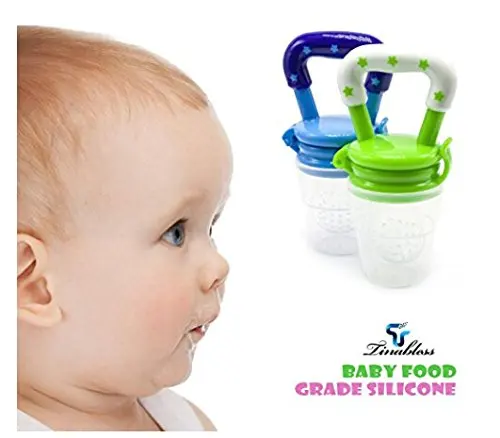 Keeping an eye on the baby does not choke on fruit juice or saliva
Keeping an eye on the baby does not choke on fruit juice or saliva - After use, wash every part of the fixture, paying attention to the net itself
- Cleaned feeder should be dried
Attention: Over time, the fabric of the mesh may darken or stain with berry juice. In this case, replace the grid.
At what age can you give your baby a Nibbler
You can give a Nibbler to your baby after weaning. To avoid allergic reactions, you need to give products that the child has already met in a puree state.
Traditionally, complementary foods should be started at 6 months of age. It is this age that is indicated on the packaging of the feeder. However, due to individual characteristics, the doctor recommends that some babies start complementary foods from 4 to 5 months. Such children can start using the nibbler earlier.
Tip: when choosing a nibbler for a baby under six months old, it is worth choosing a smaller model. For a 6 month old, buy a larger chew net.
Nibbler Safety Rules
The nibbler is a safety device, but it is important to supervise the baby while using it and follow some safety precautions:
- Do not use the chew net as a pacifier or toy
- Nibbler parts should be inspected for signs of wear and damage before each use. It is worth paying attention to the integrity of the grid itself
- If breaks, loose threads and similar problems are found, the mesh must be replaced. Do not give a baby a nibbler with a damaged mesh
Advantages of using a nibbler
Every baby will sooner or later learn to chew food, but a nibbler will speed up this process. Here are the undoubted advantages of its use:
- Chewing on the nibbler mesh, the baby is safe, and the parents are calm. He will not choke on a large particle. The baby gnaws on the mesh, turning its contents into mush and sucking out the juice
- In difficult times of teething, the feeder will be a great helper.
 The braided mesh massages baby's itchy and swollen gums, making it easier for baby teeth to come in. Place chilled fruit slices in the net: this will relieve the pain of sore gums in a child
The braided mesh massages baby's itchy and swollen gums, making it easier for baby teeth to come in. Place chilled fruit slices in the net: this will relieve the pain of sore gums in a child - It is convenient to use the nibbler while walking. Sitting in the stroller, the baby enjoys his favorite fruit, and the mother is not worried that he will choke
- The bright colors and details of the nibbler are pleasing to the eye and attract the attention of the child, bringing joy
- Nibbler is very convenient to use. All parts are easy to clean
Is it worth it to accustom a child to a pacifier
In addition to the nuances of the start of complementary foods, all mothers are interested in the issue of using a pacifier. Should the baby be forced to suck on a pacifier or under no circumstances should it be given? You can often hear from grandmothers and girlfriends that this is extremely harmful. Is it so?
Even in ancient times, there were various prototypes of a modern latex or silicone pacifier: pebbles smoothed with water, leather teats from the udder of cows, shreds in honey syrup.